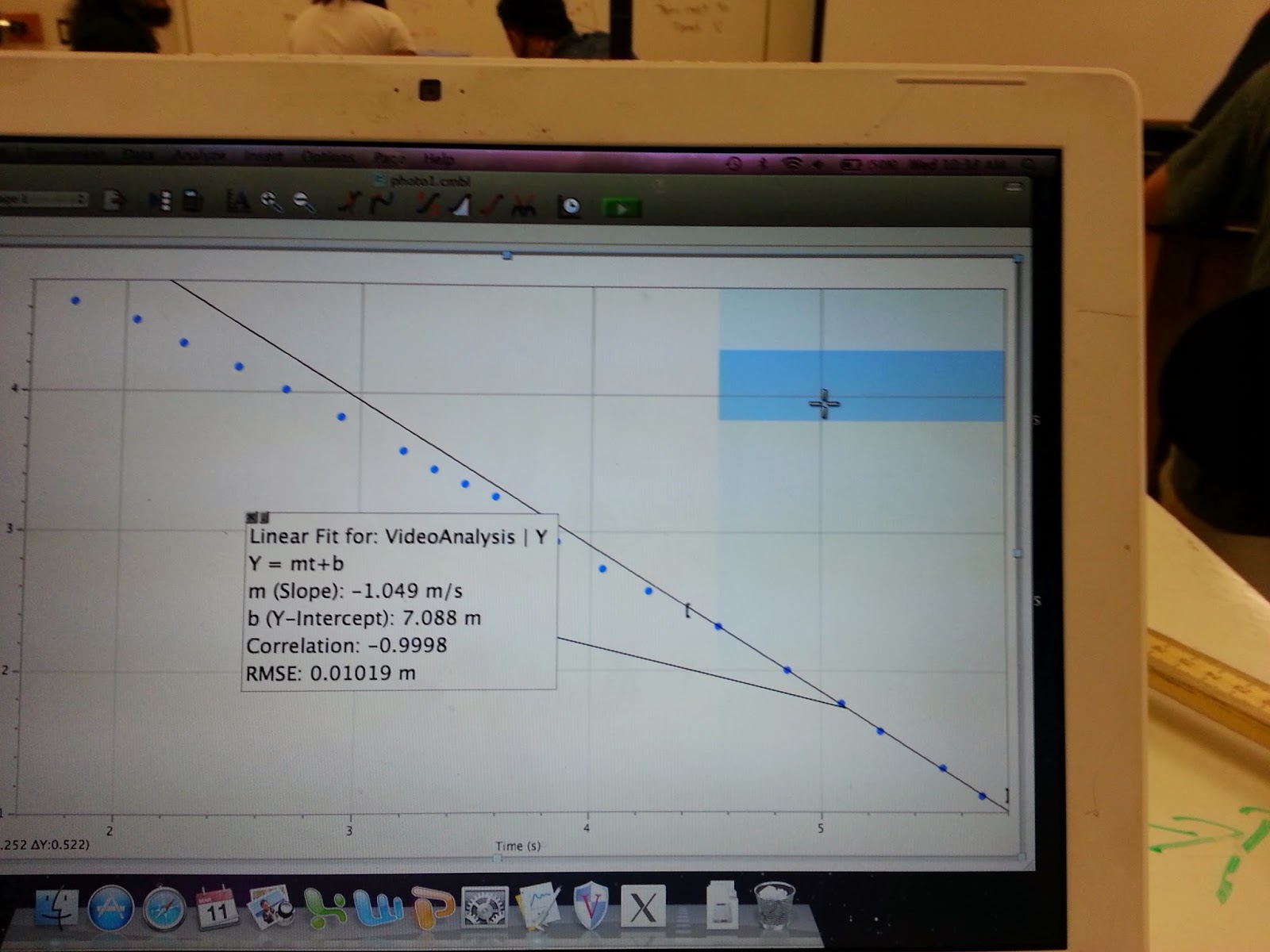Lab 5
The purpose of this lab to test the free fall with air resistance using the coffee filter.
As we all know, every experiment we need to set up equipment.
 Equipment:
Equipment:
1) Enough coffee filters to start the free fall.(Because the filter is big and light, so we air resistance is big enough.)
2) A mac computer with LogPro and excel.
1.Start the lab.
We have enough coffee filter, set them as 5 groups, in which each has one filter and add one by each group, so we have 1, 2, 3, 4, and 5. Also we calculate the the weight of the coffee filter.(because the coffee filter is very light, so we can calculate such as 50 of them and get one.), so one is 0.926 g.
By using the labPro, it has the capture option so that we can capture the motion and calculate the time, distance, and velocity.
Let one of your classmate standing in almost 3 meter floor. Checking the camera in computer see if you have whole view from the top to bottom, and then we need to do is start collect option in your logPro and told your classmate to let group one free fall and capture the whole falling from the beginning and end and save it and do it with group 2, 3.. until you get 5 perfect video.(In each video you should have like a meter so that we can use it as a measurement in our video.)
Using the logPro video option and point the coffee filter position from beginning and end. It will give a picture with position vs time graph

We got 5 graph show about position vs time graph. As we can see, I chose last 5 points and linear fit it because we want to know the free fall in which means that the air resistance is equal to mg; the acceleration is 0.(At the beginning of all graphs, that's not good enough.)
Because the acceleration is zero; the velocity should be same. That's mean the slope of the graph is velocity v.
2.Checking
We know we use mg - F= ma, in a perfect world the acceleration may not be zero, thats' mean mg is not equal to F air resistance.
However, let's assume that mg is equal to F.
We input the velocity, mass, force(is the mass because they are same.)
Then we made a force vs velocity graph, and power fit it.
We got F = A*V^B A = 0.01258 +- 0.002242 B=1.497+-0.2451
3. Testing
The goal here is to the mathematical model we developed in part 1 to predict the terminal velocity of our various coffee filters
We are testing our experiment by saying that mg is not equal to F.
How we test our results are that we using F = A*V^B A = 0.01258 +- 0.002242 B=1.497+-0.2451 to test when the acceleration is not zero and the mg is not equal to F and see if the acceleration is zero what's the velocity is and compare the velocity we got with the computer velocity.
How we test our results are that we using F = A*V^B A = 0.01258 +- 0.002242 B=1.497+-0.2451 to test when the acceleration is not zero and the mg is not equal to F and see if the acceleration is zero what's the velocity is and compare the velocity we got with the computer velocity.
By using excel, we input all the variables and function and set up a small enough interval time △t (because if the time interval is small enough, we can velocity increase and decrease with same rate and also can use the newtons law to calculate the acceleration.)
This the rules that we put in excel.
△t = 0.1 or 0.01s(small enough)
t2= △t+ t1
△v2= a1 * △ t
a1=9.81 m/s^2
a2= a1 - (k/m)*v^n (k=A=0.01258, n=B=1.497)
△x = △t*(v2+v1)/2
x2= x1 + △x
Here are the pictures
To show how to do the experiment, I chose one good sample which m =0.002778kg, v= 1.686m/s, we got from our experiment.(group 3).
We can see the results from picture
After the all steps are good, △t = 0.01. We can see that when t=1.33, acceleration a is almost very close to 0, the velocity v = 1.675942 very close to the results we got in the early experiment. So our experiment is very good.
This the rules that we put in excel.
△t = 0.1 or 0.01s(small enough)
t2= △t+ t1
△v2= a1 * △ t
a1=9.81 m/s^2
a2= a1 - (k/m)*v^n (k=A=0.01258, n=B=1.497)
△x = △t*(v2+v1)/2
x2= x1 + △x
Here are the pictures
To show how to do the experiment, I chose one good sample which m =0.002778kg, v= 1.686m/s, we got from our experiment.(group 3).
We can see the results from picture
After the all steps are good, △t = 0.01. We can see that when t=1.33, acceleration a is almost very close to 0, the velocity v = 1.675942 very close to the results we got in the early experiment. So our experiment is very good.









没有评论:
发表评论